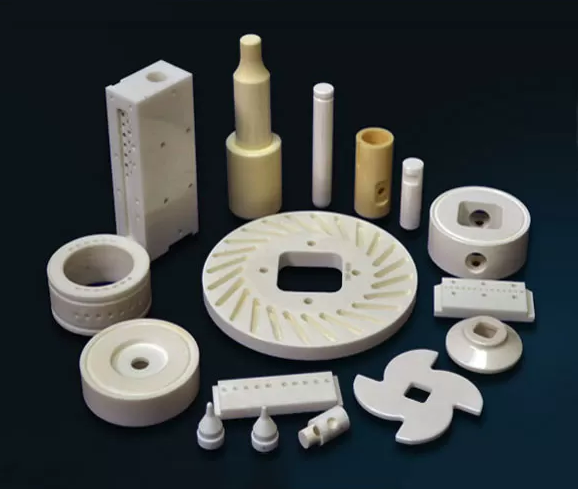What is technical ceramics? technical ceramics, that is, ceramics for industrial production and industrial products. It is a type of fine ceramics, which can perform mechanical, thermal, chemical and other functions in applications. The main technical ceramics refer to those ceramics that are mainly used in chemical plants for filtration and purification, and they are also used to grind materials.

Advanced Technical Ceramics Produced by Mingrui Ceramics
Because technical ceramics have a series of advantages such as high temperature resistance, corrosion resistance, abrasion resistance, and erosion resistance, they can replace metal materials and organic polymer materials for harsh working environments, and have become traditional industrial transformations, emerging industries and high-tech industries. An indispensable important material, it has very broad application prospects in the fields of energy, aerospace, machinery, automobiles, electronics, and chemicals. The use of corrosion-resistant, chemically stable ceramics in contact with biological enzymes is used to produce crucibles for smelting metals, heat exchangers, biological materials such as artificial dental lacquer joints, etc., and unique ceramics that capture and absorb neutrons are used to produce various nuclei Anti-pile structural materials, etc.
As a professional manufacturer and supplier of technical ceramics, Mingrui Ceramics introduces what is technical ceramics and the application of technical ceramics here.
technical ceramics refers to ceramic products used in various industries. technical ceramics can be divided into two categories: ordinary ceramics and special ceramics.
1) Ordinary ceramics
Ordinary ceramics refer to clay ceramics, which are made by firing clay, feldspar, and quartz in a proportion. Its performance depends on the purity, particle size and ratio of the three raw materials. Generally, it has hard texture, corrosion resistance, non-oxidation, non-conductivity, can withstand a certain high temperature and has good processing and formability.
Application:
Ordinary ceramics in industry are mainly used for electrical porcelain for insulation, chemical porcelain with higher acid and alkali requirements, and porcelain for structural parts with lower load-bearing requirements, such as insulators, corrosion-resistant containers, pipes and decorative porcelain in daily life, and tableware. Wait.
This ceramic is a ceramic with AL2O3 as the main component (AL2O3 mass fraction is >45%). According to the difference of the main crystal phases in the porcelain blank, it can be divided into corundum porcelain, corundum-mullite porcelain and mullite porcelain; also According to the mass fraction of AL2O3, it can be divided into 75 porcelain, 95 porcelain and 99 porcelain.
Application:
Alumina porcelain has high melting point, high hardness, high strength, and has good chemical resistance and dielectric properties. But it has high brittleness, poor impact resistance and thermal shock resistance, and cannot withstand drastic changes in ambient temperature. It can be used to manufacture high-temperature furnace tubes, furnace linings, spark plugs of internal combustion engines, etc. It can also manufacture high-hardness cutting tools, and it is also a good material for manufacturing thermocouple insulating sleeves.
3) Silicon carbide ceramics
The biggest feature of silicon carbide ceramics is high high-temperature strength, high thermal conductivity, high wear resistance, corrosion resistance, and creep resistance. It is often used as high-temperature sintered materials in scientific and technological fields such as national defense and aerospace, that is, it is used for manufacturing. High temperature parts such as the nozzle of the rocket tail nozzle, the throat used for pouring metal, the thermowell, the furnace tube and so on.
Maybe you also want to know 4 Sintering Processes of Silicon Carbide Ceramics.
Application:
Due to its high thermal conductivity, it can also be used to manufacture high-temperature strength parts such as blades and bearings of gas turbines, as well as materials for high-temperature heat exchangers, and encapsulation materials for nuclear fuels.
4) Lithium oxide ceramics
The main crystal phases of lithium oxide ceramic products are eucryptite (Li2O·Al2O3·2SiO2) and spodumene (Li2O·Al2O3·4SiO2), which are characterized by low thermal expansion coefficient (-0.03×10/ in the range of 100~1000℃) ℃~4.08×10/℃), good thermal shock resistance. Li2O is an out-of-network oxide, which has the function of strengthening the glass network and can effectively improve the chemical stability of the glass.
Application:
Lithium oxide ceramics can be used to make lining bricks for electric furnaces (especially induction furnaces), thermocouple protection tubes, constant temperature parts, laboratory utensils, cooking utensils, etc. The Li2O-A12O3-SiO2 (LAS) system material is a typical low-expansion ceramic, which can be used as a thermal shock resistance material. Li2O can also be used as a ceramic bond and has potential use value in the glass industry.
Zirconia ceramics are white, yellow or gray when they contain impurities, and generally contain HfO2, which is not easy to separate. Zirconia Ceramic has excellent properties such as high melting point and boiling point, high hardness, insulator at room temperature, and conductivity at high temperature.
Application:
In terms of structural ceramics, zirconia ceramics are widely used in the field of structural ceramics because of their high toughness, high bending strength, high wear resistance, excellent thermal insulation performance, and thermal expansion coefficient close to steel. Mainly include: Y-TZP grinding balls, dispersion and grinding media, nozzles, ball valve seats, zirconia molds, micro fan shafts, optical fiber pins, optical fiber sleeves, drawing dies and cutting tools, wear-resistant knives, clothing buttons, Watch cases and straps, bracelets and pendants, ball bearings, light golf batting sticks and other room temperature wear-resistant parts.

 Moble: +86 18122974730
Moble: +86 18122974730 Phone: +86 0769-85090316-8038
Phone: +86 0769-85090316-8038 Email: admin@cerampart.com
Email: admin@cerampart.com Skype: admin@cerampart.com
Skype: admin@cerampart.com Wechat: +86 18122974730
Wechat: +86 18122974730